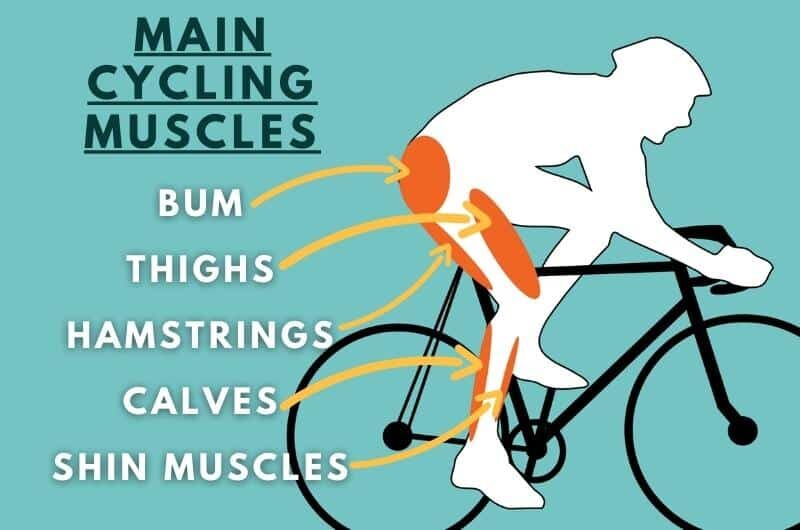Cycling can reduce thigh and belly fat as well as benefiting the circulation of blood around the body, strengthening the heart and other muscles and increasing the metabolism. It is a low-resistance exercise which means it puts less pressure on the joints than running, walking or jogging.
The visible results of cycling on fat reduction will depend upon a host of factors. But riding is proven to burn fat. Lifestyle, diet, birth gender and genetics can all influence the start and endpoints of taking fat from the belly and the thighs.
We have previously considered other physical benefits of cycling here – and on the cardiovascular system, blood circulation plus its influence on other known diseases.

Cycling Fat Loss
Fat loss, in its simplest form, is a result of a person’s body consuming (or ‘burning’) more calories than it takes in. A calorie is a unit of energy, used to show the nutritional value of food. We use this energy every day, in different measures. We even burn calories when our body is at rest.
I’m sure you’ve also seen charts charting the calories burned when doing household chores and other activities. If we work the body ‘harder’ – either for longer periods, or more intensely – we burn more calories. Charts list the calories burned for the most basic activities and cycling performs well.
For three different weights of people, cycling for 30 minutes at between 12 and 14 miles per hour burned between 240 and 336 calories. It outperforms running as the speeds increase. An average five day commute – one hour a day – could see around 1,500 calories burned.
Experiments are calculated under controlled conditions and no two amounts of calories burned are likely to be exactly the same. Our research for these articles highlights different results too. But it’s good to have a baseline to then consider how much cycling converts these batches of calorie loss into fat reduction.
A cycling magazine pulled in experts to explain how far a sporting cyclist would have to travel to burn 1kg of fat. One of the panellists said that one kilogram of fat is the equivalent of 7,800 calories.
A lot of riding is required to burn 1kg of fat and of course, the rider will be putting calories into the body over the same period, even through normal eating and drinking. Human transportation requires fuel.
Where Does Cycling Tone?
Regular cycling will see toning to a host of muscles, mainly below the waistline. Pedalling requires use of the glutes (rear-end), quadriceps (thighs), calves, hamstrings and hip-flexors. The thighs get toned the most. There is a marginal gain to arms and legs and the stomach can benefit too.
Cycling is great for muscle toning. It is a form of aerobic exercise, predominantly working the ‘slow-twitch’ muscles, needed for endurance activities. ‘Fast-twitch’ muscles are used for power activities. Slow-twitch muscles are leaner and create a narrower profile.
Body shape is likely to become slimmer as a result of cycling but only around 25% of any result will be down to cycling alone and the noticeable effects will be different amongst cycling friends or fellow commuters.

Where Does Cycling Burn Fat?
Fat is located in two main areas – under the skin and around the internal organs. You may hear these areas referred to as visceral and abdominal fat. Men and women store fat in different areas. Pre-menopausal women hold more in the glutes and thighs and men are more likely to store abdominal fat.
However, these are fat stores the body turns to only after it has emptied the shelves of the principal sources of energy – from the carbohydrates (sugars and starches) in the latest meals and then more sugars known as glucose already stored in the muscles or liver.
One good thing about cycling is that those other shelves will be depleted at a faster rate than they would be if no exercise at all took place.
How Often Should You Cycle to Lose Belly Fat?
Studies show the need to develop habits to lose fat and to keep it off. It takes the average person around 12 weeks to develop a habit and about six weeks to notice reductions in belly fat. Cycling as often and comfortably as tolerable to build the exercise into a habit will help keep the fat off.
Both the National Health Service and American Heart Association settle on fitting in around 150 minutes of moderate-intensity per week for adults to be healthy. This means being slightly out of breath during the activity – perhaps not being able to converse without a slight pause between sentences.
Based on these minimum guidelines and other lifestyle decisions such as diet, sleep and the amount of time spent being active, belly fat should start to drop, slowly for most, when exercising for more than 150 minutes per week.

How Long Does it Take to Reduce Belly Fat with Cycling?
The average person should start to see the effects of cycling on belly fat after six weeks. When increasing the intensity of exercise, belly fat reduces more quickly. One feature of more exercise is that belly fat is lost first. The rate of fat loss is slightly more pronounced in men than women.
Medical experts cannot overemphasise the importance of forming good habits when it comes to exercise, sleep and diet because control and moderation in all of these is vital to provide more likelihood of a healthier body. If diet is compromised, it might take longer to reduce belly fat.
Does Cycling Burn Fat on Thighs?
Cycling will burn thigh fat as these muscles are used the most when cycling. Fat contained there will degrade and deplete after regular workouts. Varying the cadence may hasten this process a bit. Results do take time for different body shapes and sizes.
Calories are burned all over the body and riding for a longer distance will trim more fat. Studies suggest that the thigh is around 50% muscle and 50% fat. Cycling powerfully, with bursts of energy, may build up some more muscle. However, most moderate cycling is relatively easy.
Fat can be burned more quickly by increasing the average number of pedal strokes per minute (cadence). If the cadence is between 80 and 110 revolutions per minute over a longer distance, there is an increased chance of burning more calories.
Can Cycling Help You Lose Weight?
It is medically proven that cycling can help with weight loss, in conjunction with other lifestyle and dietary choices. It’s a good activity to choose as it impacts the joints less than other forms of exercise and is recognised as giving an all-over workout. It’s also easy to slot into a busy day.
The same medics also recommend weight maintenance as being really important – if weight can be controlled, mental and psychological boosts are provided, and more often.
Cycling regularly for exercise, leisure, commuting or training is really straightforward and becoming easier and more attainable for many. If you can build a regular cycling routine into your life, it can help you on the road to a healthier life.
If you want to see how many calories you can burn while cycling, check out this free tool:
The post Can Cycling Reduce Thigh and Belly Fat? [ANALYSIS] appeared first on Discerning Cyclist.
![Can Cycling Reduce Thigh and Belly Fat? [ANALYSIS]](http://bicycle.org/wp-content/uploads/2022/07/cycling-fat-loss-760x238.jpg)
